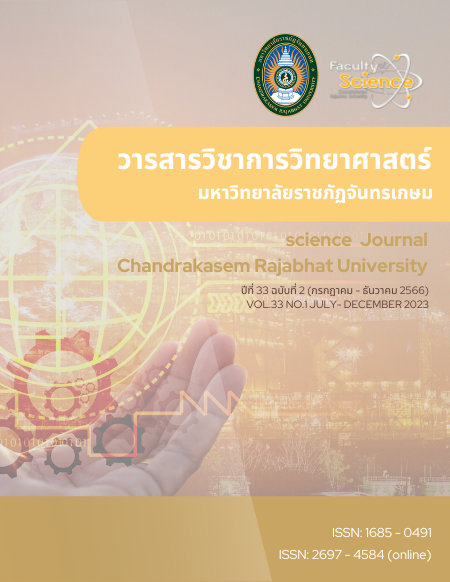การทดสอบสารพฤกษเคมี ปริมาณฟลาโวนอยด์และสารประกอบฟีนอลรวม และฤทธิ์ยับยั้งกิจกรรม ของเอนไซม์แอลฟาอะไมเลสและแอลฟากลูโคซิเดสของสารสกัดจากใบกระโดน
คำสำคัญ:
พฤกษเคมี, กระโดน, แอลฟาอะไมเลส, แอลฟากลูโคซิเดสบทคัดย่อ
งานวิจัยนี้มีวัตถุประสงค์เพื่อการทดสอบสารพฤกษเคมี ปริมาณฟีนอลและฟลาโวนอยด์รวม และฤทธิ์ยับยั้งกิจกรรมของเอนไซม์แอลฟาอะไมเลสและแอลฟากลูโคซิเดสของสารสกัดใบกระโดน (Careya sphaerica Roxb.) ตัวอย่างใบกระโดนสกัดด้วยเมทานอล ผลการทดสอบพฤกษเคมีของสารสกัดใบกระโดนพบไกลโคไซด์ แอลคาลอยด์ ฟลาโวนอยด์ สารประกอบฟีนอล ซาโปนิน เทอร์พีนอยด์ และคูมารินส์ ปริมาณฟลาโวนอยด์รวมและปริมาณสารประกอบฟีนอลรวมของสารสกัดใบกระโดนมีค่าเท่ากับ 2.88 ± 0.59 มิลลิกรัมสมมูลกรดแกลลิกต่อกรัมของสารสกัดและ 10.02 ± 0.58 มิลลิกรัมสมมูลเคอร์ซิทินต่อกรัมของสารสกัดตามลำดับ ปริมาณแทนนินมีค่าเท่ากับ 1.29 ± 0.14 มิลลิกรัมต่อ 100 มิลลิกรัมน้ำหนักแห้งของพืช ฤทธิ์ยับยั้งกิจกรรมของเอนไซม์แอลฟาอะไมเลสมีค่า IC50 เท่ากับ 0.42 ± 0.01 มิลลิกรัมต่อมิลลิลิตรและฤทธิ์ยับยั้งกิจกรรมของเอนไซม์แอลฟากลูโคซิเดสมีค่าเท่ากับ 2.97 ± 0.09 มิลลิกรัมต่อมิลลิลิตร ผลการศึกษาในครั้งนี้แสดงให้เห็นว่าสารสกัดใบกระโดนเป็นแหล่งของสารพฤกษเคมีที่มีศักยภาพในการลดระดับน้ำตาลได้
เอกสารอ้างอิง
Ahmad, L.A., & Crandall, J.P. (2010). Type 2 diabetes prevention: a review. Clinical diabetes, 28(2), 53–59. https://doi.org/10.2337/diaclin.28.2.53
Alberti, K.G.M.M., & Zimmet, P.Z. (1998). Definition, diagnosis and classification of diabetes mellitus and its complications. Part 1: diagnosis and classification of diabetes mellitus. Provisional report of a WHO consultation. Diabetic medicine, 15(7), 539–553. https://apps.who.int/iris/handle/10665/66040
Ambardar, N., & Aeri, V. (2013). A better understanding of traditional uses of Careya arborea Roxb. phytochemical and pharmacological review. Tang (humanitas medicine), 3(4), 1-7.
Baba, S.A., & Malik, S.A. (2015). Determination of total phenolic and flavonoid content, antimicrobial and antioxidant activity of a root extract of Arisaema jacquemontii Blume. Journal of Taibah university medical sciences, 9(4), 449-454. https://doi.org/10.1016/j.jtusci.2014.11.001
Björntorp, P., Holm, G., & Rosmond, R. (1999). Hypothalamic arousal, insulin resistance and Type 2 diabetes mellitus. Diabetic medicine : a Journal of the British diabetic association, 16(5), 373-383. https://doi.org/ 10.1046/j.1464-5491.1999.00067.x
Cheng, A.Y., & Fantus, I.G. (2005). Oral antihyperglycemic therapy for type 2 diabetes mellitus. Canadian medical association journal, 172(2), 213-226. https://doi.org/10.1503/cmaj.1031414
Chiasson, J.L., Josse, R.G., Gomis, R., Hanefeld, M., Karasik, A., Laakso, M., & STOP-NIDDM Trail Research Group. (2002). Acarbose for prevention of type 2 diabetes mellitus: the STOP-NIDDM randomised trial. Lancet (London, England), 359(9323), 2072-2077. https://doi.org/10.1016/S0140-6736(02)08905-5
Grover, J.K., Yadav, S., & Vats, V. (2002). Medicinal plants of India with anti-diabetic potential. Journal of ethnopharmacology, 81(1), 81-100. https://doi.org/10.1016/s0378-8741(02)00059-4
Gülçin, İ., Topal, F., Sarikaya, S.B.Ö., Bursal, E., Bilsel, G., & Gören, A.C. (2011). Polyphenol contents and antioxidant properties of Medlar (Mespilus germanica L). Records of natural products, 5(3), 158. https://doi.org/10.1016/j.fct.2010.05.053.
Gupta, P., Patil, D., & Patil, A. (2019). Qualitative HPTLC phytochemical profiling of Careya arborea Roxb. bark, leaves and seeds. 3 Biotech, 9(8), 311. https://doi.org/10.1007/s13205-019-1846-x
Iqbal, E., Salim, K.A., & Lim, L.B.L. (2015). Phytochemical screening, total phenolics and antioxidant activities of bark and leaf extracts of Goniothalamus velutinus (Airy Shaw) from Brunei Darussalam. Journal of king saud university - Science, 27(3), 224-232. https://doi.org/10.1016/j.jksus.2015.02.003
Kamble, R.P., Ghosh, P., & Kulkarni, A.A. (2022). Identification of α-amylase inhibitory compounds from leaves of Careya arborea Roxb. and in silico docking studies. South african journal of botany, 151, 493-503. https://doi.org/10.1016/j.sajb.2022.05.018.
Khaliq, H.A. (2016). Pharmacognostic, physiochemical, phytochemical and pharmacological studies on Careya arborea Roxb: a review. The journal of phytopharmacology, 5(1), 27–34. https://doi.org/10.31254/phyto. 2016.5106
Kumar, R.S., Sivakumar, T., Sundaram, R.S., Sivakumar, P., Nethaji R., & Gupta, M. (2006). Antimicrobial and antioxidant activities of Careya arborea Roxb. stem bark. Iranian journal of pharmacology & therapeutics, 5(1), 35-41.
Kwon, Y.-I., Apostolidis, E., & Shetty, K. (2008). Inhibitory potential of wine and tea against α-amylase and α-glucosidase for management of hyperglycemia linked to type 2 diabetes. Journal of food biochemistry, 32(1), 15–31. https://doi.org/10.1111/j.1745-4514.2007.00165.x
Makkar, H.P.S. (2003). Measurement of total phenolics and tannins using Folin-Ciocalteu method. In: Quantification of tannins in tree and shrub foliage. Springer, Dordrecht. https://doi.org/10.1007/978-94-017-0273-7_3
Mandal, D., Panda, N., Kumar, S., Banerjee, S., Mandal, N.B., & Sahu, N.P. (2006). Atriterpenoid saponin possessing antileishmanial activity from the leaves of Careya arborea. Phytochemistry, 67(2), 183-190.
Munglue, P., Rattana, K., Sangchanjiradet, S., Yaraksa, N., & Aoki, S. (2022). Preliminary phytochemical screening and antioxidant activity of Dioscorea alata L. Advanced science journal, 22(2): R83 - R100. Retrieved from https://li02.tci-thaijo.org/index.php/adscij/article/view/400
Satish, K.B.N., Swamy, B.M.V, Kumar, G.K., & Behera, G.M. (2010). Review on Careya arborea Roxb. International journal of research in ayurveda and pharmacy, 1(2), 306–315. https://www.cabdirect.org/cabdirect/ abstract/20113195399
Shawky, E., Sobhy, A.A., Gharee, D.A., Eldin, S.M.S., & Selim, D.A. (2022). Comparative metabolomics analysis of bioactive constituents of the leaves of different Trigonella species: Correlation study to α-amylase and α-glycosidase inhibitory effects. Industrial crops and products, 182, 114947. https://doi.org/10.1016/ j.indcrop.2022.114947
Talimi, P., & Gulcin, I. (2017). Antidiabetic potential: in vitro inhibition effects of some natural phenolic compounds on a-glycosidase and a-amylase enzymes. Journal of biochemical and molecular toxicology, 31(10), e21956. https://doi.org/10.1002/jbt.21956.
Tundis, R., Loizzo, M.R., & Menichini, F. (2010). Natural products as a-amylase and a-glucosidase inhibitors and their hypoglycaemic potential in the treatment of diabetes: an update. Mini-reviews in medicinal chemistry, 10(4), 315–331. https://doi.org/10.2174/138955710791331007.
World Health Organization. (2022). Report of the first meeting of the WHO Global Diabetes Compact Forum: virtual meeting, 10-11 November 2021. WHO Global Diabetes, Geneva, Switzerland.

ดาวน์โหลด
เผยแพร่แล้ว
รูปแบบการอ้างอิง
ฉบับ
ประเภทบทความ
สัญญาอนุญาต
ลิขสิทธิ์ (c) 2023 มหาวิทยาลัยราชภัฏจันทรเกษม

อนุญาตภายใต้เงื่อนไข Creative Commons Attribution-NonCommercial-NoDerivatives 4.0 International License.
บทความที่ได้รับการตีพิมพ์เป็นลิขสิทธิ์ของมหาวิทยาลัยราชภัฏจันทรเกษม
ข้อความที่ปรากฎในบทความแต่ละเรื่องในวารสารวิชาการเล่มนี้เป็นความคิดเห็นส่วนตัวของผู้เขียนแต่ละท่าน ไม่เกี่ยวข้องกับมหาวิทยาลัยราชภัฏจันทรเกษม และคณาจารย์ท่านอื่นในมหาวิทยาลัยแต่อย่างใด ความรับผิดชอบองค์ประกอบทั้งหมดของบทความแต่ละเรื่องเป็นของผู้เขียนแต่ละท่าน หากมีความผิดพลาดใดๆ ผู้เขียนแต่ละท่านจะรับผิดชอบบทความของตัวเองแต่เพียงผู้เดียว

 สำหรับผู้แต่ง (Author)
สำหรับผู้แต่ง (Author)





